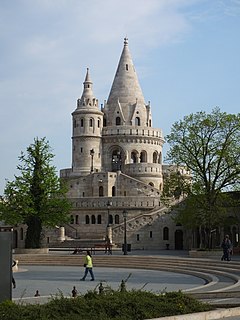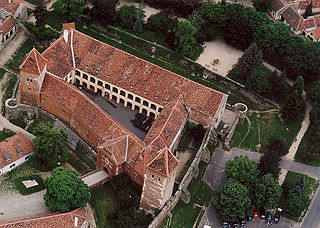 W
WAndrássy Avenue is a boulevard in Budapest, Hungary, dating back to 1872. It links Erzsébet Square with the Városliget. Lined with spectacular Neo-renaissance mansions and townhouses featuring fine facades and interiors, it was recognised as a World Heritage Site in 2002. It is also one of Budapest's main shopping streets, with fine cafes, restaurants, theatres, embassies and luxury boutiques. Among the most noticeable buildings are the State Opera House, the former Ballet School, the Zoltán Kodály Memorial Museum and Archives, the Hungarian University of Fine Arts, and the Ferenc Hopp Museum of East Asian Arts.
 W
WBuda Castle is the historical castle and palace complex of the Hungarian kings in Budapest. It was first completed in 1265, but the massive Baroque palace today occupying most of the site was built between 1749 and 1769. The complex in the past was referred to as either the Royal Palace or the Royal Castle. The castle now houses the Hungarian National Gallery and The Budapest History Museum.
 W
WBudapest is the capital and the most populous city of Hungary, and the ninth-largest city in the European Union by population within city limits. The city has an estimated population of 1,752,286 over a land area of about 525 square kilometres. Budapest is both a city and county, and forms the centre of the Budapest metropolitan area, which has an area of 7,626 square kilometres and a population of 3,303,786, comprising 33% of the population of Hungary.
 W
WThe Cathedral of Hajdúdorog, officially Greek Catholic Cathedral of the Presentation of Mary in Hajdúdorog is the cathedral of the Archeparchy of Hajdúdorog, Hungary. This status ranks the cathedral among the most important buildings of the Hungarian Greek Catholic Church. The origins of the current cathedral reaches back to 1312, when historical notes mention that a church existed in the medieval settlement of Dorogegyháza. However, the present building has 17th century foundations, and it went through several building extensions and renovations during its history. The latest restoration were completed in 2006.
 W
WThe Dohány Street Synagogue, also known as the Great Synagogue or Tabakgasse Synagogue, is a historical building in Erzsébetváros, the 7th district of Budapest, Hungary. It is the largest synagogue in Europe, seating 3,000 people and is a centre of Neolog Judaism.
 W
WThe Primatial Basilica of the Blessed Virgin Mary Assumed Into Heaven and St Adalbert, also known as the Esztergom Basilica, is an ecclesiastic basilica in Esztergom, Hungary, the mother church of the Archdiocese of Esztergom-Budapest, and the seat of the Catholic Church in Hungary. It is dedicated to the Saint Mary of the Assumption and Saint Adalbert.
 W
WThe Halászbástya Hungarian pronunciation: [ˈhɒlaːzbaːʃcɒ] or Fisherman's Bastion is one of the best known monuments in Budapest, located in the Buda Castle, in the 1st district of Budapest. It is one of the most important tourist attractions due to the unique panorama of Budapest from the Neo-Romanesque lookout terraces. The Fishermen's Bastion's main façade, parallel to the Danube, is approximately 140 meters long, of which the southern aisle is about 40 meters long, the north is 65 meters long, and the ornate central parapet is 35 meters long. Its seven high-pitched stone towers symbolize the seven chieftains of the Hungarians who founded Hungary in 895.
 W
WPart of the famous Hotel Gellért in Buda, the Gellért Thermal Baths and Swimming Pool, also known simply as the Gellért Baths, is a bath complex in Budapest in Hungary.
 W
WThe Budapest Hall of Art or Palace of Art,, is a contemporary art museum and a historic building located in Budapest, Hungary.
 W
WHősök tere is one of the major squares in Budapest, Hungary, noted for its iconic statue complex featuring the Seven chieftains of the Magyars and other important Hungarian national leaders, as well as the Memorial Stone of Heroes, often erroneously referred as the Tomb of the Unknown Soldier. The square lies at the outbound end of Andrássy Avenue next to City Park (Városliget). It hosts the Museum of Fine Arts and the Műcsarnok. The square has played an important part in contemporary Hungarian history and has been a host to many political events, such as the reburial of Imre Nagy in 1989. The sculptures were made by sculptor Zala György from Lendava.
 W
WThe Hungarian National Gallery, was established in 1957 as the national art museum. It is located in Buda Castle in Budapest, Hungary. Its collections cover Hungarian art in all genres, including the works of many nineteenth- and twentieth-century Hungarian artists who worked in Paris and other locations in the West. The primary museum for international art in Budapest is the Museum of Fine Arts.
 W
WThe Hungarian National Museum was founded in 1802 and is the national museum for the history, art, and archaeology of Hungary, including areas not within Hungary's modern borders, such as Transylvania; it is not to be confused with the collection of international art in the Hungarian National Gallery. The museum is in Budapest VIII in a Neoclassical building, purpose-built during 1837–47 by the architect Mihály Pollack.
 W
WThe Hungarian Parliament Building, also known as the Parliament of Budapest after its location, is the seat of the National Assembly of Hungary, a notable landmark of Hungary, and a popular tourist destination in Budapest. It is situated on Kossuth Square in the Pest side of the city, on the eastern bank of the Danube. It was designed by Hungarian architect Imre Steindl in neo-Gothic style and opened in 1902. It has been the largest building in Hungary since its completion.
 W
WThe Hungarian State Opera House is a neo-Renaissance opera house located in central Budapest, on Andrássy út. Originally known as the Hungarian Royal Opera House, it was designed by Miklós Ybl, a major figure of 19th-century Hungarian architecture. Construction began in 1875, funded by the city of Budapest and by Emperor Franz Joseph I of Austria-Hungary, and the new house opened to the public on the 27 September 1884. Before the closure of the "Népszínház" in Budapest, it was the third largest opera building in the city; today it is the second largest opera house in Budapest and in Hungary.
 W
WBudapest's Inner City Parish Church (Church of the Blessed Virgin Mary) is the main parish church of Budapest. It is located adjacent to the walls of the Contra-Aquincum Fortress and the Elisabeth Bridge. Its earliest features date back to the Romanesque period. In 1046 Bishop St. Gellért was buried there. The 14th century Hungarian King Sigismund, supported the Gothic reconstructed style. During the reign of King Matthias, two new side ships were added. It was used as a mosque in Turkish times and its memory is a miracle (imafülke) in the south-eastern wall of the sanctuary. After a fire in 1723, between 1725 and 1739, it was restored in baroque style, under the direction of the master builder György Pauer János (1692-1752). In 1828, István Kultsár, the great theater organizer of the era of Enlightenment, was placed in the church's vault for eternal rest. In 1839, it was built with stalls selling the buttresses, which were dismantled in 1932. Then they found the Gothic windows and the twin bed.
 W
WJurisics Castle, named after Croatian nobleman Nikola Jurišić is located in Kőszeg, Hungary.
 W
WThe Church of the Assumption of the Buda Castle, more commonly known as the Matthias Church, more rarely the Coronation Church of Buda, is a Roman Catholic church located in the Holy Trinity Square, Budapest, Hungary, in front of the Fisherman's Bastion at the heart of Buda's Castle District. According to church tradition, it was originally built in Romanesque style in 1015, although few references exist. The current building was constructed in the florid late Gothic style in the second half of the 14th century and was extensively restored in the late 19th century. It was the second largest church of medieval Buda and the seventh largest church of the medieval Hungarian Kingdom.
 W
WThe Museum of Applied Arts is a museum in Budapest, Hungary. It is the third-oldest applied arts museum in the world.
 W
WThe Museum of Fine Arts is a museum in Heroes' Square, Budapest, Hungary, facing the Palace of Art.
 W
WSt. Stephen's Basilica is a Roman Catholic basilica in Budapest, Hungary. It is named in honour of Stephen, the first King of Hungary, whose right hand is housed in the reliquary. It was the sixth largest church building in Hungary before 1920. Since the renaming of the primatial see, it's the co-cathedral of the Roman Catholic Archdiocese of Esztergom-Budapest. Today, it is the third largest church building in present-day Hungary.
 W
WThe Széchenyi Chain Bridge is a chain bridge that spans the River Danube between Buda and Pest, the western and eastern sides of Budapest, the capital of Hungary. Designed by English engineer William Tierney Clark and built by Scottish engineer Adam Clark, it was the first permanent bridge across the Danube in Hungary. It was opened in 1849. It is anchored on the Pest side of the river to Széchenyi Square, adjacent to the Gresham Palace and the Hungarian Academy of Sciences, and on the Buda side to Adam Clark Square, near the Zero Kilometre Stone and the lower end of the Castle Hill Funicular, leading to Buda Castle.
 W
WThe Lukács Thermal Bath is a historic indoor/outdoor thermal bath spa in Budapest, Hungary, heated naturally by hotsprings. It can be used by men and women everyday, however the swimming pools have historical names such as men swimming pool and women swimming pool. There are ticket with lockers or cabins. All pools and 4 saunas can be used by all ticket basically. The only optional area is the sauna world, which contains 5 more extra saunas, ice cooling pool, igloo and heated roman bench. There are sauna nights in this bath on fridays of every even week from 20:00 to 02:00.
 W
WThe Széchenyi Medicinal Bath in Budapest is the largest medicinal bath in Europe. Its water is supplied by two thermal springs, their temperature is 74 °C (165 °F) and 77 °C (171 °F).
 W
WVáci utca is one of the main pedestrian thoroughfares and perhaps the most famous street of central Budapest, Hungary. It features many restaurants and shops catering primarily to the tourist market. The Lonely Planet says "It's tourist central, but the line of cafés and shops are worth seeing — at least once."